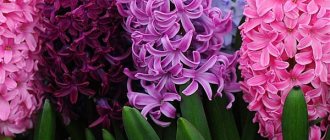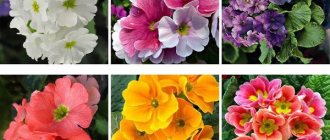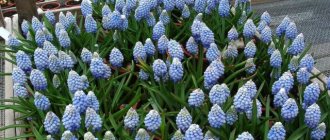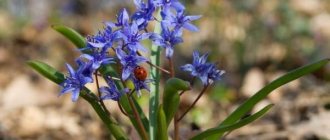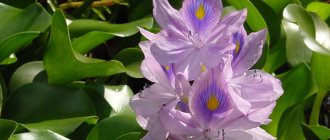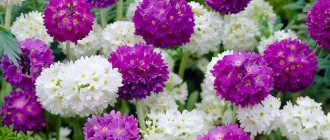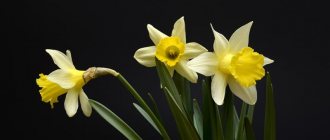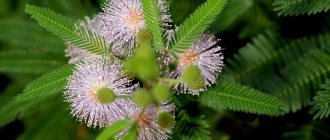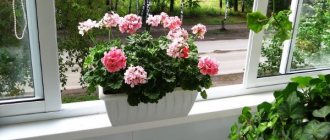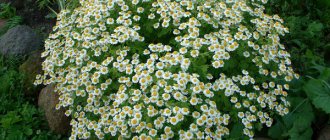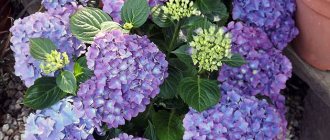How to choose the right one?
Before purchasing a potted plant in a store, determine the purpose of purchase .
If hyacinth is needed only for a gift, pay attention exclusively to the density of the brush, the number and beauty of the buds, and the straightness of the peduncle. The synchronicity of flower blooming and the condition of the upper and lower tiers of the cluster are assessed to ensure long-term flowering.
What to pay attention to if you need planting material:
- the upper part of the bulb rises above the ground;
- there is no damage, defects or rot on the bulb;
- the peduncle is slender, straight, without curvature;
- leaves are fresh, green, fleshy;
- The plant stands upright in the pot and does not fall on its side.
If the bulb, stem, or leaves show signs of rotting, wilting, drying out, damage or fungal infection, you should not buy such a plant, even at the lowest price.
Forcing indoor hyacinths in water
Another interesting option for forcing is in water. To do this, use tall vases or glasses, widened at the top.
Forcing hyacinths in water
The technology of distillation in water is quite simple:
- Place the hyacinth bulb at the top of the vase and pour water into it. The water level should be just below the bottom of the bulb.
- The vase with hyacinth is placed in a dark place (refrigerator) at a temperature of 5-7°C for 10-16 weeks.
- During the cooling process, monitor the water and, if necessary, add it to the required level.
- Gradually the bulb will grow long white roots and sprout. When it reaches 2-3 cm, you can take the vase into a warm place.
Three stages of development
The bulbous perennial hyacinth cyclically goes through three phases of development throughout the year:
- In spring, the bulb “wakes up” - leaves grow, a peduncle emerges, and buds bloom. Under natural conditions, flowering occurs in March-May, which is determined by the variety. The growing season lasts approximately 3 months (March, April, May).
- By summer, the plant fades, and seed pods form on the peduncle. The leaves remain green in June. The bulb stores nutrients through its leaves for future growth and prepares for a long rest. The transitional phase of accumulation of reserves and transition to dormancy falls in June. Until the end of June, the onion is dug up for storage.
- At the end of September/beginning of October, the bulb is planted in the soil. The long stage of winter dormancy begins. The bulb will “sleep” in the soil all winter and come to life again in the spring.
In stores for the holidays, hyacinths are sold after forcing - an artificial displacement of natural biorhythms for flowering within a given time frame. The potted plant is weakened after forcing and needs special care .
Classification by color
The easiest way to classify plants is by color and popularity. There are six types:
- Blue hyacinth in a pot (Perle Brillante, Mary);
- Lilac hyacinths (Blue Magic, King Indigo);
- Pink hyacinth (Anna Marie, Gertrude);
- Red flowers (Hollyhock, Tubcrgen's Scarlet) are especially popular double varieties for growing;
- White hyacinth (Arentine Arendsen);
- Blooming hyacinth, colored yellow or orange (Yellow Hammer).
It is quite difficult to systematize varieties, taking into account demand or popularity. A house flower is selected based on its decorative qualities, cost, commercial availability, individual preferences, and the properties of other plants on the street are analyzed (whether all flower components are compatible). Among the most popular “rain flowers” are varieties such as Bimark, Delph Blue, Dilight, Lord Balfour, Edison, Jan Boss.
Hyacinths in an eco-friendly interior
Purple hyacinths
Actions after purchase
The desired container with a good, healthy flower was purchased and safely delivered home. The duration of the current flowering and the possibility of reusing the bulb depend on the correct home care.
Do I need to replant?
As a rule, the plant is brought from the store in a small pot with a small amount of substrate.
Hyacinth should be watered regularly during the flowering period; water should not get on the bulb; moisture should not stagnate. It is better to pour water into the pan.
A cramped store container will not be able to ensure normal moisture circulation.
The soil of the purchased plant in a pot is very poor and poor in mineral elements. Hyacinth will suffer from lack of nutrients. Therefore, a transplant is needed so that the hyacinth feels comfortable, blooms beautifully and makes a good reserve for the future.
Which container should you choose?
Choose a pot for transferring hyacinth, following the recommendations:
- A plastic, clay, ceramic pot is suitable;
- the main condition is the presence of drainage holes at the bottom;
- container size – depth 15 cm, diameter 9 cm for one onion;
- a drainage layer of fine expanded clay is poured onto the bottom, and a layer of clean sand on top;
- Loose, light, non-acidic soil, purchased specifically for bulbous plants, is placed on the drainage.
Drainage is extremely important for hyacinth; stagnation of water provokes rotting and death of the bulb .
Planting in another container
It is very important to carefully transfer the bulb along with a lump of earth into a new spacious container. This process is called transshipment. It is necessary to preserve the root system and rosette at the base of the bulb as much as possible.
Transshipment is done in one confident movement , preventing the root ball from scattering and exposing the roots. Sprinkle soil on top, leaving the top third of the bulb free. Spray the soil once with a weak solution of an antifungal agent.
How to properly prepare the soil for planting
For forcing hyacinths, light, loose soil is required. You can purchase it at specialized outlets or prepare it yourself. To do this, combine soil from the garden, peat and coarse sand in equal parts, and mix everything thoroughly. For acidic soil, add dolomite flour according to the instructions on the package.
The substrate is poured into the pot, leaving a third of the height empty (not forgetting the drainage layer), lightly compacted and watered. No additional additives are added to the planting soil mixture, since all the necessary nutrients are already contained directly in the bulb.
Growing conditions at home
A hyacinth transplanted into a spacious pot needs watering, fertilizing, lighting and maintaining temperature and humidity conditions.
Lighting and location
The best place for blooming hyacinth in an apartment is a well-lit eastern or southeastern window sill. The lack of natural light is compensated with a fluorescent lamp .
The total time a flowering plant spends in the light should approach 15 hours per day.
The perennial will like it on a cool but insulated loggia or balcony . However, the flower does not tolerate direct sunlight. In this case, shading and periodically turning the plant with different sides towards the light are required. Otherwise, the peduncle will tilt to one side.
Protect hyacinth from drafts and sudden temperature changes. It is highly undesirable to place hyacinth near heating devices (radiators, radiators, stoves).
The faded hyacinth is gradually reduced in lighting and moved to the north side. They are completely removed from the light when the leaves and stem have withered and the bulb has stocked up.
Temperature
The plant loves coolness, constant temperature without changes . The optimal flowering temperature for hyacinth is 16-18oC. This regime will prolong flowering up to 4 weeks. If you leave hyacinth at 20-22oC, the flowering period will be reduced to 2-3 weeks.
Air humidity
During the flowering period, hyacinth needs a humidity of 80%. If the air in the apartment is dried by heating radiators, it is worth buying a special humidifier or periodically spraying water from a spray bottle. At the same time, moisture should not get on the flower itself. Daily wet cleaning will help maintain a comfortable microclimate in the room.
Watering and fertilizing
The flowering period requires daily watering of the plant with settled or melt water at room temperature. The watering technique consists of uniformly moistening the substrate, avoiding water getting on the bulb and peduncle. The best solution is for the plant to absorb water from the pan. After flowering, water much less often, wait for the leaves to wilt and stop moisturizing completely.
Feeding for hyacinth:
- when the first leaves appear - calcium nitrate;
- when releasing a peduncle - with a special mineral fertilizer;
- after flowering - superphosphate.
Fertilizing is especially necessary for indoor and potted plants to form a high-quality peduncle for the next season.
An alternative option is to plant the bulbs back into the pot (forcing)
If it is not possible to identify a hyacinth bulb in a garden flower garden, it can be sprouted at home. This will essentially be a re-forcing. Most likely, this secondary flowering will be weaker than the first.
Therefore, it is better to purchase new healthy bulbs for forcing. In the fall, stores sell a lot of planting material with the note “ready for forcing.” Buy them. You can also use your own bulbs grown in exhaust gas, but you need to be careful in choosing them.
Hyacinth bulbs for forcing should be:
- large – at least 5 cm in diameter;
- with a healthy bottom;
- with a hard smooth surface;
- not affected by rot, diseases, pests;
- without traces of mechanical damage.
In the fall, many varieties of hyacinth bulbs go on sale—there are plenty to choose from!
What should you do with the bulbs in order to grow flowering hyacinths from them? To begin with, the bulbs are planted in a pot and cooled for 10-16 weeks at a temperature of 5-7°C. Then they expose the plants to light, in a warmer room and wait for flowering.
That is, the most important thing in forcing is to properly maintain the cooling period of the bulbs. A suitable place for this is a balcony, basement, garage or bottom shelf of the refrigerator.
Note!
Avoid storing bulbs near fruits (especially apples) or vegetables that produce ethylene gas, which can damage the bulbs.
The time for planting the bulbs depends on the time by which they want to get blooming hyacinth. Average planting times (with a cooling period of 12 weeks):
- for the New Year or Christmas - the bulbs are planted until mid-September;
- by February 14 and February 23 - at the end of October - beginning of November;
- by March 8 – until mid-November.
Technology for forcing hyacinths at home:
- Select a pot with drainage holes, 15-20 cm high, 2-4 cm wider than the diameter of the bulbs.
- Nutrient substrate - a ready-made mixture for bulbous flowers or universal soil, diluted with sand and sawdust. The soil must be loose.
- The bulbs are pickled in a dark pink solution of potassium permanganate or Maxim for about 30 minutes.
- A centimeter layer of drainage and soil are poured into the pot to half the height of the pot. The bulbs are planted so that the top (1/3 of the height) remains on the surface. On top is a layer of sand. Several bulbs are planted in one pot at a distance of 2-2.5 cm from each other and from the walls of the container.
Planting hyacinth bulbs in a pot for forcing - The pots are placed in a dark place at a temperature of 5-7°C. A paper bag will help protect the planting from light. The plants should remain in this state for 10-16 weeks.
You can store hyacinth plantings in the refrigerator - During the rooting period, maintain light soil moisture. Water only in the corners of the pot.
- After 2 months the first shoots will appear. When they stretch to 2-2.5 cm, the pots are transferred to a bright, cool room.
When the hyacinths hatch and grow small “beaks”, they can be taken indoors - For the first 3-4 days, the air temperature should not exceed 10-12°C. The paper cap is not removed yet.
- Then the temperature is increased to 15-20°C. Remove the paper bag, but continue to shade the flower from the bright light. This is necessary so that the pale yellow-green sprouts, which were previously constantly in the dark, acclimatize and do not receive a “light” shock.
In a warm room in the light, hyacinths quickly begin to grow
Hyacinth blooms on average 15-20 days after it is transferred to a warm room.
The blossoming of hyacinths is a bright event dedicated to the holiday
Further care according to the standard scheme: maintain humidity and feed once every 2 weeks. If necessary, arrange additional lighting.
How long does it bloom at home?
The lifespan of one bulb can reach 10 years with proper care and periodic planting in open ground.
The flowering period is regulated by temperature. Coolness from 15 to 17oC will stop the wilting process and prolong the life of the inflorescences. A moderately warm atmosphere of 20-22oC will speed up the opening of buds and shorten the flowering period.
What should the pot be like?
A pot made of any material can serve as a container for growing hyacinth. The following container parameters are considered an important condition for normal development and growth:
- It is advisable to choose a low but wide pot.
- It is better to choose clay containers. The material will regulate soil moisture.
- There must be drainage holes in the bottom.
Fulfilling these conditions when choosing a container is enough for the plant to “feel” comfortable.
How to care for different stages of development?
The technique for caring for home bulbous primrose varies depending on the phase of plant development.
During the rest period
The dormant period for a house plant replaces winter . Conditions are created that are close to the natural environment. The onion planted in the pot is covered with a paper cap and placed on the bottom shelf of the refrigerator for storage. Check periodically, moisturize, not allowing it to dry out.
The appearance of a sprout up to 5 cm in size means the arrival of spring. The plant is moved to a warmer room, to a closed balcony, for example, to give access to lighting. As soon as the first buds form, the hyacinth is brought into the home and placed on the windowsill.
During bud formation
During flowering, care involves maintaining optimal levels of cool temperature and humidity. Adjust the illumination with a special lamp. Intensely flowering hyacinth is fed with mineral fertilizers. Protect from heat, direct sunlight and drafts, temperature changes, and stagnant water.
What to do next when the flowers have faded?
When the perennial has faded, proceed as follows::
- remove the peduncle;
- until the leaves wither, continue to water, but do it much less often;
- move the pot with fading flowers to a less sunny side;
- before the end of June, the onion is removed from the soil, cleaned, and the tops are cut off;
- dry for 3 days at room temperature;
- placed on the bottom of a box with holes and a bottom lined with paper;
- cover with paper or dark, breathable fabric;
- June, July keep the bulb at a temperature of 25-27oC away from light and moisture;
- in August, lower the storage temperature to 17oC;
- in mid/late September the bulb is planted back into the ground.
It is not recommended to drive out one bulb twice in a row. Periodically planting it from a pot into open ground will extend the life of the bulb.
What care should be given to hyacinth after flowering?
Inexperienced flower growers are at a loss as to what to do with hyacinth after it has bloomed. It all depends on whether they intend to get another full-fledged plant from this bulb. If not, the flower is dug up and thrown away. But you can do it differently: dig up the bulb and transplant it into the garden. Here it will rest and produce new flowers, provided it is properly cared for.
If you intend to start propagating and further growing hyacinths, proceed as follows.
- When the plant fades, cut off the flower.
- Continue moderate watering and fertilizing until the remaining leaves on the trunk wither. During this period, the bulb will gradually increase in size and children may appear.
- Next, the bulb is removed from the soil and cleaned of dried leaves. If there are children, separate them.
- Those bulbs that have flowered after forcing are not suitable for replanting. But they can be planted in the ground in a flower bed or garden.
The maximum “lifespan” of hyacinth bulbs is 10 years. All this time they produce flowers once every 1–2 years.
Planting in open ground
Coachman hyacinth bulbs are planted only when they want to get lush flowering
On average, hyacinths bloom for 1.5–2 weeks. At the final stage, drying of the peduncle and leaves is observed. From this point on, watering is gradually reduced and stopped completely after the flower dries.
Attention! You cannot cut off the green mass and flowers before they dry out, since during this period there is an outflow of nutrients into the bulb.
The peeled onion is planted in the ground at a temperature of +20–30°C. The optimal period is the first half of autumn. Planting is carried out to a depth of 10–12 cm on dense heavy soils and 12–15 cm on loose and light soils.
- A hole of appropriate depth is formed.
- Pour a 1–2 cm layer of sand onto the bottom.
- The distance between the bulbs is 8–9 cm.
- Before frost, cover the planting site with a 10 cm layer of mulch.
Reproduction
There are several methods for propagating hyacinths:
- seeds – used in breeding work;
- leaves - a labor-intensive, inconvenient and unpopular method;
- by children - separated from the mother bulb, planted separately, plants are obtained from the second year;
- bulbs - initially using purchased material, this is the most common and affordable method;
- By cutting out the bottom of the bulb, a large number of large, viable children are achieved. They are subsequently planted to produce new hyacinths.
Gardeners recognize the method of cutting out the bottom of the bulb as the most promising and fastest . The method is relatively simple and accessible even to inexperienced gardeners.
Useful properties of hyacinth
Dried hyacinth petals are filled into sachets to scent bed linen. Things scented in this way retain the smell of freshness and cleanliness for a long time. It is believed that hyacinth emits strong energy, spreading in a spiral from the roots to the upper tier of flowers. The plant improves general condition and improves mood. But the smell can cause headaches, so it is not recommended to place the flower in the bedroom or children's room.
Diseases and pests
Unfortunately, even house plants are susceptible to diseases and pest attacks:
- white rot of bulbs;
- gray rot;
- fusarium;
- onion mite;
- onion hoverfly;
- stem nematode.
The cause of fungal diseases and pest damage is improper watering, the use of contaminated soil or containers for planting. Diseases can be prevented by treating the bulbs with Hom before planting .
Sprinkling plants with a solution of colloidal sulfur will protect them from pests. A good prevention is to follow the rules for planting and caring for flowers.
What to pay attention to during the growing process
During the growing process, some metamorphoses may occur with the plant, which will signal problems and improper care.
- If the leaves begin to turn yellow at the edges, it means that at the very beginning a small onion was selected and subjected to forcing.
- When the buds begin to fade quickly, you should choose a more suitable place for the flowerpot - remove the pot with the flowering plant from the sun and away from heating devices. Reduce the room temperature to 12 °C.
- If the edges of the leaves begin to dry out and curl, it is worth checking the bush for the presence of pests, viral and bacterial fungi.
You should carefully monitor the irrigation regime, as the flower does not like excess moisture and high air temperatures.
Problems and mistakes in caring for indoor plants
Hyacinths are considered quite capricious and demanding to care for.
It is not surprising that both beginners and experienced gardeners make a number of mistakes that lead to negative consequences. Most common problems :
- rotting of the plant - lack of drainage, water gets on the bulb or stem when watering;
- weak flowering stem with small flowers – violation of the temperature regime of storage;
- pale flowers, loose, sparse cluster of inflorescences – lack of soil microelements;
- yellow leaves - drafts, high temperature;
- wilted leaf tips - insufficient lighting, dry air, no air circulation;
- the peduncle is tilted to one side - uneven lighting;
- fracture of the peduncle under the weight of the inflorescences - the soil is too nutritious and moist, such an inflorescence can be supported;
- buds falling off - too hot or cold, draft, temperature difference;
- dried leaves mean hard water for irrigation; instead, you should use settled or melt water.
The rapid wilting of hyacinth and the falling of collected buds may be a consequence of damage by aphids, nematodes, or mites. It is better to get rid of the infected specimen immediately , since it is unlikely to be revived.
Popular types of hyacinth
All possible hyacinths can be divided into three main types, which grow mainly in Mediterranean countries. Although botanists continue to debate regarding some varieties, wanting to designate them as independent, according to official data, only the following main types of hyacinths are distinguished:
Oriental hyacinth (Hyacinthus orientalis) is the most famous and widespread species. It is from this species that the most famous ornamental varieties come. It grows wild in Dalmatia, Greece and Asia Minor. The peduncle of the plant is thin, the flowers are located sparsely. The flowers have different colors and a pleasant aroma.
Hyacinth Litvinov is a perennial herbaceous plant that is cultivated more as an annual. In the wild, it is found in the eastern regions of Iran and Turkmenistan. Among this species there are both tall and short specimens. The flower is extremely beautiful. Blue, purple and greenish colors dominate. The leaves are slightly wider than those of the oriental hyacinth.
Transcaspian hyacinth - has fairly tall stems, usually two peduncles. The color of the flowers is always light blue. In the wild, it is found in the Kopetdag mountains.
Types and varieties
Hyacinths (Hyacinthus) belong to the large family of asparagus plants and originate from the Mediterranean basin - they originally grew from Asia Minor to Palestine. They grow from scaly onions, producing lanceolate leaves and one to several flowering shoots. Within these plants, only three species stand out: the very popular oriental hyacinth (Hyacinthus orientalis), the deciduous Lithuanian hyacinth with wide leaves (Hyacinthus litwinovii) and the dwarf Caspian hyacinth (Hyacinthus transcaspicus) with blue, grape-like inflorescences. However, eastern hyacinths rule garden stores, which breeders divide into four groups of varieties.
Dutch hyacinths are the most popular and most widespread varieties. Their flowers can be single or double. They are prized for their wide range of colors and exceptional size and density of inflorescences. They usually reach 30 centimeters in height.
• White varieties: “White Pearl”, “Carnegie”, “L'Innocence”
• Yellow varieties: “Yellow Queen”, “City of Haarlem”
• Orange varieties: “Gypsy”
• Pink varieties: 'Pink Pearl', 'Anna Marie', 'Fondant'
• Red varieties: “Jan Bos”
• Blue varieties: “Blue Jacket”, “General Koehler”, “Crystal Palace”
• Purple varieties: “Amethyst”, “Woodstock”
• Black varieties: “Dark Dimension”
Roman (French) hyacinths are much lower and less lush than their predecessors. They grow to about 15 centimeters, and their flowers are located quite freely on the shoots.
Miniature hyacinths are even smaller than the Roman varieties, reaching a maximum of 10 centimeters in height.
Multiflora hyacinths reach a height of 15 cm, and their characteristic feature is the release of several flowering shoots from one onion.
About current issues
It takes a lot of effort to grow hyacinth; caring for it at home is also associated with difficulties caused by diseases and pests. Among the main reasons that provoke illnesses in bright spring flowers are:
- Using pre-infected planting material (if there is a pathogen in the substrate, the plant will immediately react to it);
- The soil is too acidic and heavy (before watering the hyacinth, the water is first prepared using soil acidity correctors);
- Using fresh organic matter, which cannot be tolerated by any type or variety of hyacinths;
- Using an area where predecessors previously lived that were not friendly to the “flower of rains”;
- If you plant a hyacinth that is rotten or otherwise spoiled, growing and caring for it will be especially difficult;
- Dense landing.
Hyacinth is truly a sophisticated and capricious flower. You need to take care of plants with special care. If all conditions are met, spectacular flowering will delight amateur gardeners year after year.
Hyacinths in a vase
Hyacinths in window decoration
Secrets of transplanting a flowering crop
The plant should be replanted after it has flowered.
- To do this, you need to cut off the peduncle and choose a larger container, on the bottom of which you put expanded clay or sand.
- Then, using the transshipment method, without damaging the root system, move the hyacinth, adding fertile soil around the edges.
- It is important not to bury the bulbs. About a third of the part should be located above the surface.
- Sprinkle a small layer of sand 1 cm thick on top of the soil.
Transplanting into a pot involves placing the plant in a well-lit and cool room. Hyacinth will not keep you waiting long and will quickly delight you with new green foliage. In the future, proper care and development of the transplanted plant will be organized naturally.
To grow beautiful and strong indoor flowers, you should properly care for them, know how to replant them at home and protect them from possible dangers. And then the flowers in pots, surrounded by attention, will decorate the apartment with bright blooms and an elegant appearance.
Which varieties are suitable for home forcing?
We can say that many varieties of garden hyacinth can be grown in a pot. But there are many types of hyacinth, and only one of them is suitable for forcing in an apartment - this is the Eastern hyacinth.
The most beautiful and popular varieties are:
- Innosan,
- Ostara,
- Amethyst,
- Lord Balfour,
- Gypsy Queen,
- Carnegie.
Thanks to the efforts of breeders from all over the world, many colorful varieties of hyacinths have been developed that are also suitable for growing indoors.
Decorating containers with hyacinths
If you are a lover of decorative things, try growing a flower in a beautiful jar or jug that is collecting dust in the attic.
In such containers, distillation can be done in water or in wet sand.
There are special vases for forcing hyacinths. They look like an hourglass, the lower part of which is a water reservoir, and the upper part is a bulb holder.
In a decorative flask
Only the bottom of the onion should be immersed in water. But it is recommended to do forcing in containers.
Various mosses can be used to decorate and reduce water evaporation from the soil surface.
If you use decorative jars, you need to make a support for the bulb.
It is necessary to ensure that the water reaches only the bottom of the onion - the bottom.
The flask with the onion can be left in a cool, frost-free place until the sprouts appear. A tip is to check the water level regularly.
When the sprouts reach three centimeters and the roots reach ten, it will be possible to bring hyacinths indoors. The temperature should be 12-15°C.
Flowers in a vase with decorative stones
No need to screw the bulbs into the ground! We pour fine gravel into a glass container and place the bulbs in the center so that they are at the same distance from each other.
